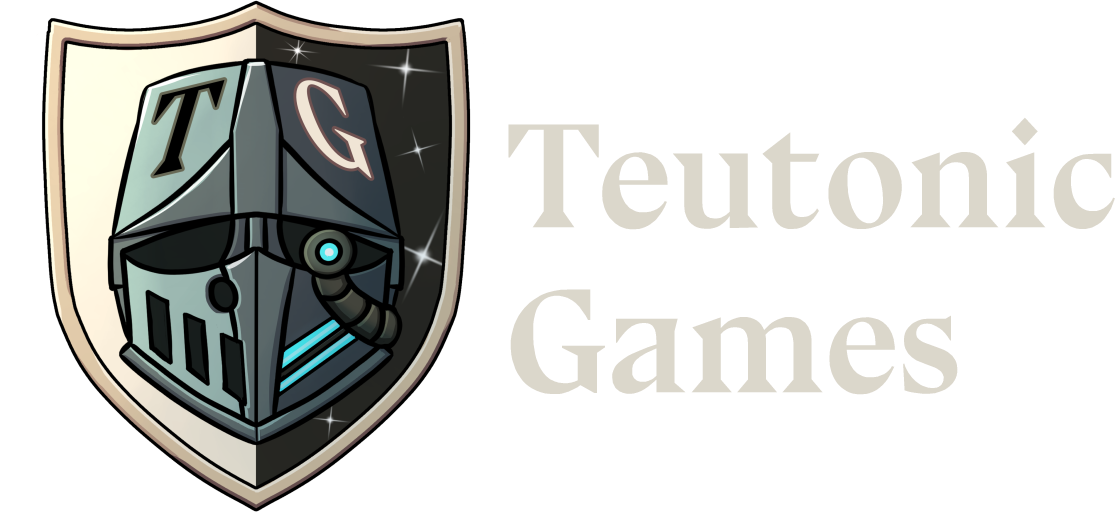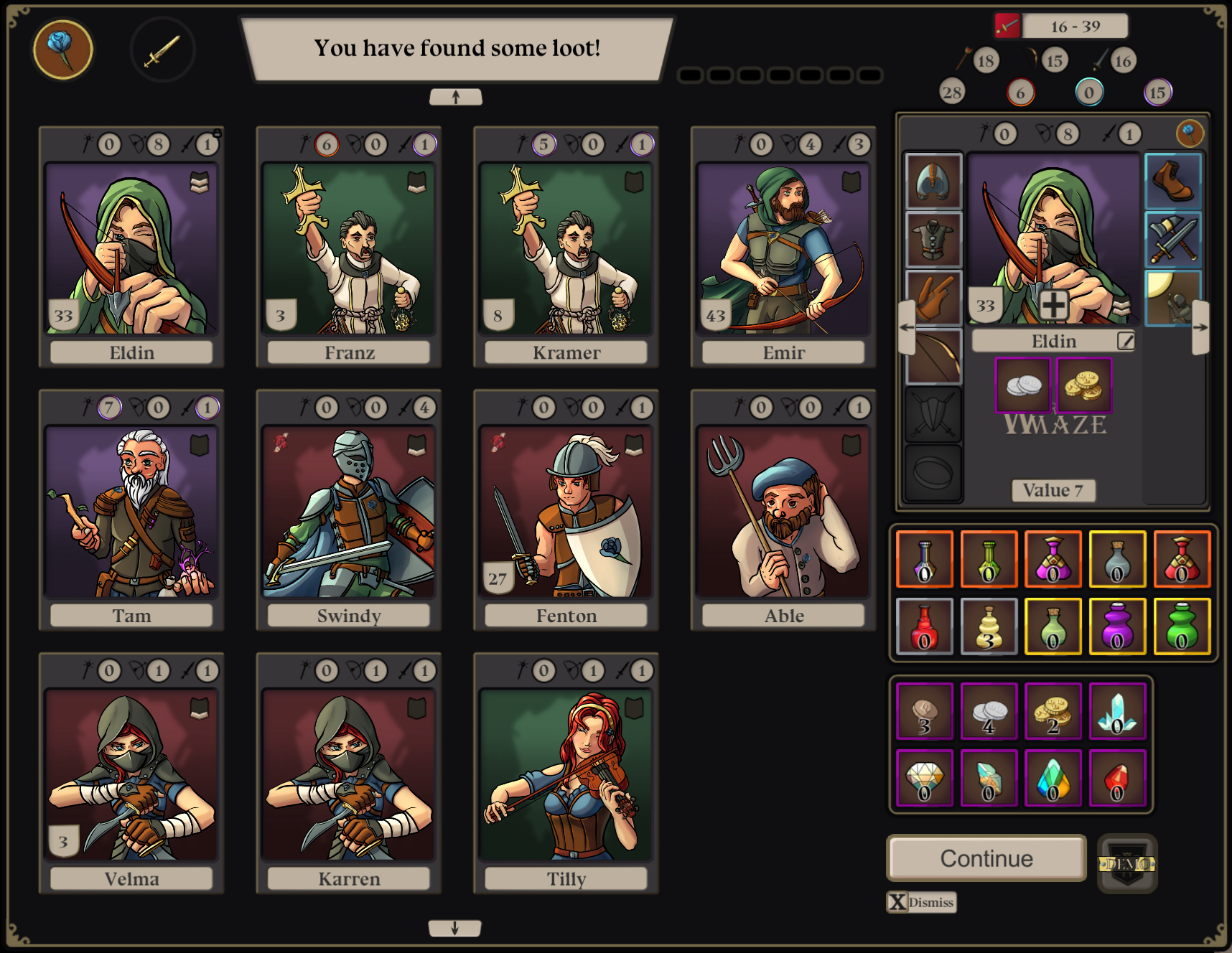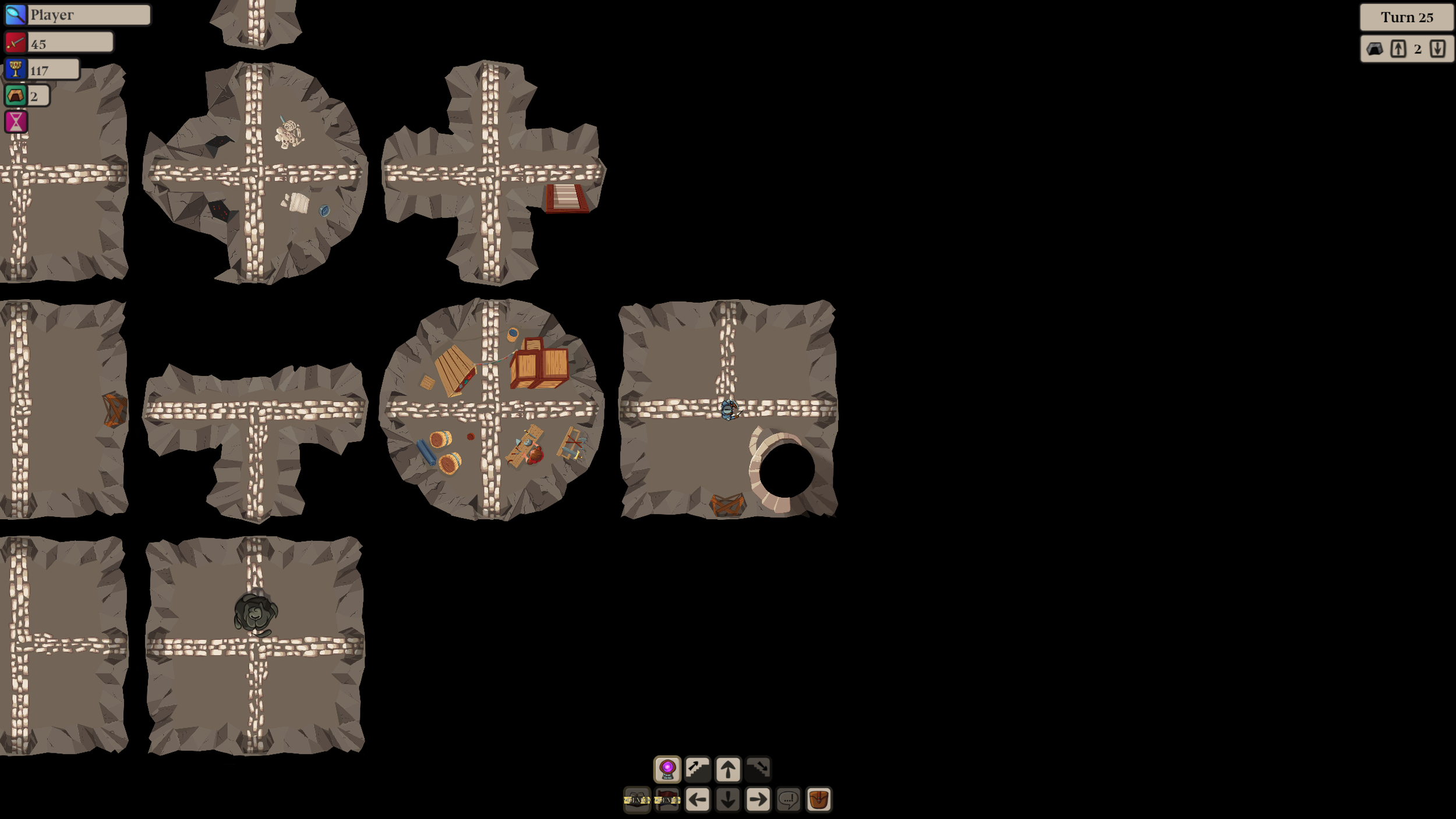
Your Party
Your party can range from a disciplined force representing a single faction to a ragtag group of adventurers, outlaws, and even monsters you picked up along the way.
The one thing that unites them is the faction your party represents. It might begin as a small expedition sent by the Thornreachers and end as a rambling mess without a single human left to witness the outcome. Even so, the banner they fight under remains the same.
By being selective with who you recruit and hire, you can steer the party in a clear direction. You can also dismiss the less... desirable elements that happen to find their way in—or even send them to the front lines and simply “forget” to give them any support.
Members
A party that stays together grows together. By honing their skills, intuition, and camaraderie over time, the party will begin to function more effectively—making it easier to gain an edge in battle. However, a party in constant turmoil will gradually start to break down as stress levels rise.
Mettle & Prowess
While the party system offers deep and complex mechanics under the surface, we've designed the interface to make managing it feel intuitive and streamlined. Whether it's using a shortcut to grab a potion or visual cues that help you quickly distribute loot across a large party, our goal is to let you engage at your own pace—without ever feeling overwhelmed or at a disadvantage.
Strategic Depth, Streamlined Design
Units
There are three types of power values; Magic, Ranged & Melee. A unit’s power level influences how likely it is to come out on top in combat, as well as how risky an engagement will be for them.
The power value is associated with a damage type, by default its Physical damage, but it can also be Magical, Fire or Ice, indicated by a purple, red or blue circle around it.
Likewise, a unit can have a corresponding body type. The default physical type has no impact, but beings made by ice or fire have considerably less risk when engaging in combat. Those with magic bodies are immune to all non-magic attacks.
Fire damage reduces ice-based protection, ice damage reduces fire-based protection, and magic damage weakens protection provided by magical entities or magic-infused bodies.
Power Values & Damage Types
Gear comes in three main categories; Armour, Weapons and Trinkets.
Armour is equipped to one of three areas: head, body, or hands. Weapons are assigned to either the main hand or off-hand, while trinkets—such as potions, amulets and rings—grant you a bonus when you need it most.
Some gear require a specific attribute value to be equipped, for example a leather armor requires 2 strength.
Proficiencies impact how good a unit is at different things, the primary ones are the gear proficiencies that will boost the benefit a units gets from certain types of gear. For example; If a unit is proficient with swords a Longsword will give it +2 melee power instead of +1.
When dragging an item, any unit proficient with it will be highlighted with a golden glow. The glow intensifies if that unit’s corresponding gear slot is currently empty.
There are, however, other types of proficiencies that can significantly impact the outcome of certain events. Some allow units to perform unique actions—like breaking through blocked passages, provided they have the right tools for the job.
Gear & Proficiencies
Abilities come in three flavors, the generally beneficial ones (blue frame), the detrimental ones (black frame) and those that reduce your units combat abilities (red frame). They are further grouped in to Aspects, Conditions, Magic, Skills, States and Traits (each group has a different background color on the icon).
Abilities can do several different things such as; alter how your unit interacts with other party members (making some social events more or less likely), they can impact how likely the unit will be to succeed at a particular event check, and finally, it can impact the unit’s combat performance.
The ability descriptions are intentionally left vague, but you should be able to pick up some hints here and there for what they are good for. For example, some abilities will trigger effects on units in combat and then you will see that abilities icon flash over that unit.
Abilities
A units faction shows where their allegiances lie. There are currently three playable factions (Thornreachers, Goldhammers and Redtusks) and an additional 5 NPC factions. A party normally starts with all units belonging to the same faction, however as the game progresses you’re likely to pick up a few new compatriots here and there.
But be careful with who you pick up, not all factions get along as well as others.
Faction
As your units prove themselves in the maze they will level up and gain different benefits, such as stat increases or defense bonuses.
Levels
Exploration
The maze is randomized every time you enter it, at it’s base it’s built up of 3 different types of tiles, rooms, special rooms, and corridors. Each turn, you can move to an adjacent tile, potentially encountering other parties, discovering loot, triggering events that challenge your units.
Special tiles hold encounters that are a bit extra, it may be a tavern or a merchant, or you might find yourself in the middle of a dragons lair or looking down a deep pit.
Diving In To the Maze
Occasionally, when you explore a new tile, you'll encounter an event. These events present a scenario where you must choose a course of action and assign a unit you believe is best equipped to deal with it.
Events can come with great rewards such as powerful abilities or magical items if your chosen one is successful, but they can also pay a terrible price if they fail, so choose wisely.
Editors Note: If one more of my most kitted out mages suddenly gets transformed to a basic archer I’m going to scream..
Events
Encounters
The primary way of growing your party is approaching groups of NPCs that you encounter in the depths of the maze. If they are friendly enough a few of them might join you, if they are hesitant then perhaps a few gold coins might help persuade them. Some individuals in your party possess unique skills that allow them to recruit or persuade others to join your cause. These abilities can be powerful, enabling you to grow your forces without combat. But beware, if your silver tongue turns to lead, they might turn their weapons on you before your units have time to react.
It might be safer to try your luck at a tavern instead, if you can find one.
Negotiate & Recruit
Approaching the same party multiple times and parting on neutral terms will make them more acquainted with you and more sympathetic to your cause. So if you get turned away once, don’t get deterred, as sometimes persistence pays.
Combat
In large rooms combat takes place over 6 lanes (horizontal), where each side has a front line (melee) and back line (magic & ranged). In corridors the space is a bit more restricted, maneuvering and combat is subsequently limited to two lanes.
Each side takes turns placing two units at a time. Once you're satisfied with the board state, you can initiate combat. The outcome is determined by the power balance in each lane, with a dice roll adding an element of chance. Results—such as deaths, injuries, and other consequences—are then presented. If both sides still have combat-ready units, you’ll have the option to continue the fight or cut your losses and retreat. If not, a victor is declared and a full combat summary is shown.
General
Combat always carries risk—your opponent might land a lucky hit, or simply outmatch you in strength. These factors are reflected in each lane’s Risk Factor, which represents the percentage chance that one (or more) of your units could die. This risk is dynamically adjusted during combat based on lane advantages, power differences, and dice rolls.
However, risk can be mitigated. A unit’s defense, armor, shields, defensive tactics, and reflexes can reduce or even negate fatal damage—allowing them to survive blows that might otherwise be deadly.
Risk & Mitigation
Most combat oriented abilities, that affect other units, will flash an ability icon over the affected units when they are triggered. So keep an eye out for those. Any effects that are triggered like this, will create a corresponding ability on the affected unit to help you keep track of what's going on.
Tactics allow you to influence the tide of combat—but they’re not chosen directly. Instead, they’re triggered by placing the right units in the right positions. Each unit brings its own tactical potential, and careful placement can activate powerful effects that turn the battle in your favor. Think ahead—your choices could be the difference between victory and defeat.
Most units can flank, giving a power bonus to their allies. Three melee units with a shield placed next to each other will form a shield wall, thus reducing the risk factor for the one in the middle of it. Letting a lone ranged unit face off against two opponents in their lane, while getting flanked on both sides is generally a very bad idea, no matter how powerful they are.
Tactics
There are plenty of tactics for you to discover in the maze, mastering them will give you the skills needed to take on more challenging fights.
Most abilities will grant some sort of benefit or disadvantage in combat, but some are more combat oriented than others.
For example, the Guardian ability can grant another unit in the lane the Shielded ability, which prevents them from getting injured, however, it makes it more likely that the guardian dies instead of his ally (if it comes to that).
Another combat ability to look out for is the Dragonfire ability. Any unit that has it will breathe out fire, hitting both opponents in its lane and any back line unit directly next to them.





